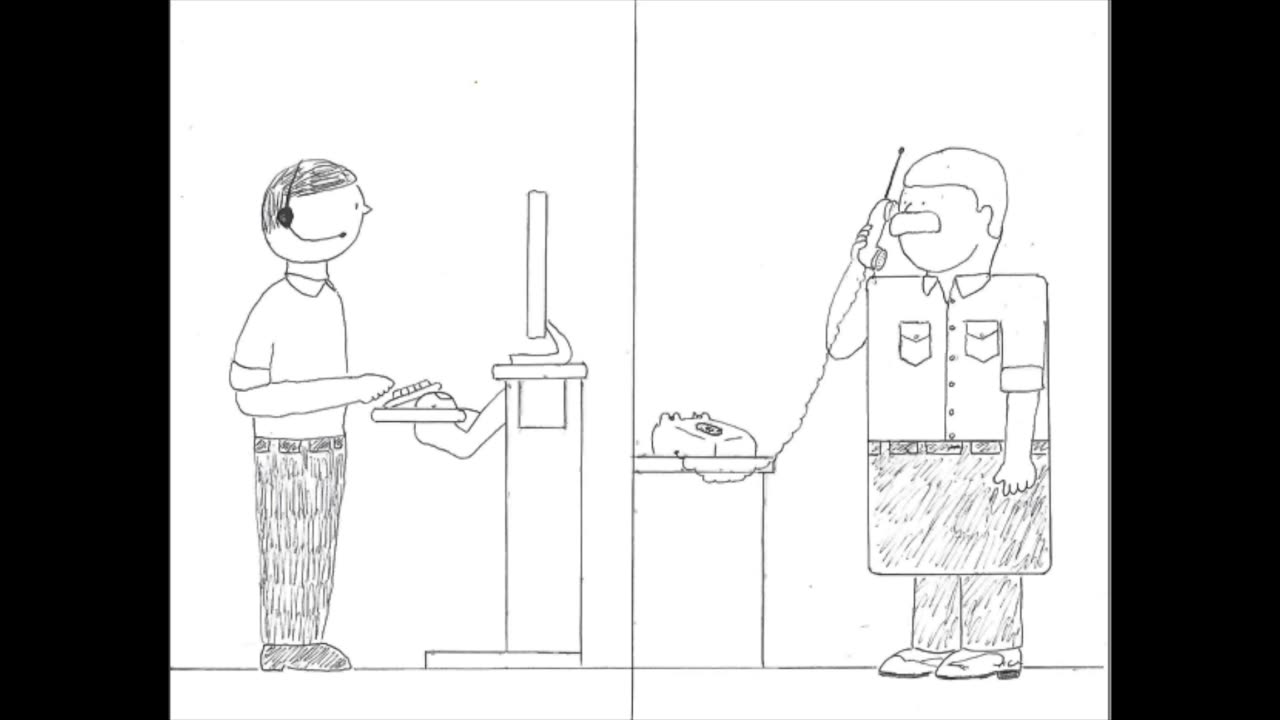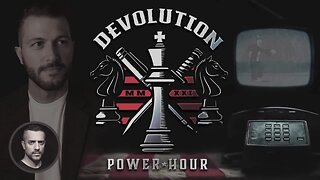Premium Only Content

I Tried Improvisation, Then I Was Perturbed
A tribute (of sorts) to the 1981 hit song “867-5309/Jenny” written by Alex Call and Jim Keller and performed by Tommy Tutone. The premise of the skit, though, was actually inspired by a letter a member of our troupe received from a charity which has fuchsia as its dominant color. The front of the envelope said that he was cordially invited to an “event.” He had donated to the charity before, so he was quite elated to receive this letter, thinking it was perhaps a donor party. He had never been invited to a donor party before. He was looking forward to going to the party and meeting fellow donors and hearing from people who were helped by the non-profit. When he opened the letter, he got quite a different story. The non-profit was wasn’t inviting him to a donor party, rather it was inviting him to participate in a fund raiser. Essentially, he felt like the charity wasn’t asking him to come to this “event,” rather, this charity was asking his credit card to come to the event. Needless to say, he never gave to the non-profit again. This sketch is a spoof of that moment where the non-profit takes fund raising to the next level, bypassing the “middle man” (i.e., the cardholder, Jenny E. Tutone) and talking directly to the card (Mr. 5309).
Opening scene: The opening scene is poking fun at the “Sitting is the New Cancer/Sitting is the New Smoking” movement. Many studies have linked extended sitting to such illnesses as obesity, high blood pressure, high cholesterol, cardiovascular disease and cancer-related deaths. Standing desks have been proposed as remedies, presumably by commission-hungry salesmen, overpaid ergonomists desperately trying to justify keeping their jobs by designing new and difficult-to-use devices, and CEOs looking to maximize their stock bonuses on their overpriced, American-researched, European-designed and Chinese-manufactured office furniture (pardon our off-the-cuff cynicism).
However, we at CoBaD argue that there is really more to consider here: factors such as stress (at work and home), genetics (e.g., history of high blood pressure), and, most important of all, lifestyle choices (exercise, sleeping and eating habits) all play a role in an individual's health (or lack thereof). All of these factors must be taken into consideration when looking at causes of obesity, high blood pressure, etc. And even if working at a standing desk decreases a worker’s risk of cancer (and as you can see, cancer is linked to just about everything in life), he or she puts himself at other risks with standing desks, as standing all day can lead to illnesses such as varicose veins and foot discomfort. It just seems to us here at CoBaD that simply getting up and walking around from your seated desk every hour is a better way of combating the “New Cancer” rather than lining a corporation's pockets by purchasing their cancer-free office furniture.
Finally, there is the increased disruption that results from working at standing desks. A member of our troupe took an industrial ergonomics class many years ago and seemed to recall that a person should take a brief break from a sitting posture (e.g., stand up, stretch and walk around) every 60 minutes before sitting back down for another hour. If one is in a standing posture, then one needs to take a break every 30 minutes. Standing desks, unless you are a horse, cow or a sleeping camel (or other such animals who have the God-given stamina to stand for long durations) will just lead to an overall reduction in work productivity compared to conventional seated desks. So it appears to us here at CoBaD that standing desk advocates are essentially thinking like Alfred Hitchcock who once famously said “I deny that I have ever said actors are cattle. What I said was: ‘Actors should be treated like cattle.’”
Caller: "Good evening. Is this Ms. Jennifer E. Tutone?" - Jenny’s middle initial is E. Her middle name, of course, is Eightsixsevenfivethreeohnine.
Director: “Improv is in direct violation of your Work Made for Hire Agreement!” – A Work Made for Hire Agreement is basically a contract between a contributor (e.g., an actor or an actress) and an organization he or she is contributing to (such as CoBaD).
Director: “Title 14, Chapter 1, Subchapter 4, part 91 subpart b section 123, paragraph a stipulates: ‘When a sketch has been rehearsed, no actor or actress in command may improvise in that sketch unless an edited script is obtained from the director (c’est moi), an emergency break in the routine exists, or the deviant behavior is in response to a turning point conflict resolution punchline. An actor or actress may cancel a line if and only if the operation is being conducted in improv conditions. All improv activity, to wit: lazy, meandering and hideously and embarrassingly unfunny and forgettable performances, in perpetuity, throughout the universe, in any and all media whether now or later known or devised, and by any and all technologies and means of delivery whether now or later known or devised, are confined to the director’s bedroom only.’ And your Payment clause states: ‘Director’s payment obligation is conditioned on Contributor’s full performance of all of the Services and obligations.’ And since this is not my bedroom, no taste of honey!” - This is a spoof of the Code of Federal Regulations (Aerospace and Space) paragraph “Compliance with Air Traffic Control Clearances and Instructions.” The paragraph actually reads:
“When an ATC clearance has been obtained, no pilot in command may deviate from that clearance unless an amended clearance is obtained, an emergency exists, or the deviation is in response to a traffic alert and collision avoidance system resolution advisory. However, except in Class A airspace, a pilot may cancel an IFR flight plan if the operation is being conducted in VFR weather conditions. When a pilot is uncertain of an ATC clearance, that pilot shall immediately request clarification from ATC.”
The joke here is the juxtaposition of flying and comedy. A member of our troupe took both improv and comedy sketch writing classes. He also took airplane flying lessons and has a private pilot license and an instrument rating. He felt that sketch comedy is very much like flying under Instrument Flight Rules (IFR): very set, rigid, and all participants (in the case of flying, the pilot and air traffic control, and in the case of comedy sketches, the cast and crew) know what is coming next. Improv, on the other hand, is very much like flying under Visual Flight Rules (VFR): more freedom, but just like VFR flying is limited to specific weather conditions (e.g., cloud cover and visibility), improv comedy is limited to audience suggestions.
The director’s line “All improv activity, to wit: lazy, meandering and hideously and embarrassingly unfunny and forgettable performances…” is a jab at the drawbacks of improv. Many bad premises are generated on the stage, but because the players are stuck with what the audience suggested, and they have a set time they have to fill on stage, these “meandering and hideously and embarrassingly unfunny…performances” go on much, much longer than they should. For example, in one improv performance we had the misfortune to witness, an audience member suggested to a male and female improv player that they play a scene set in the year 1812. It was very painful to watch because it was immediately obvious that these two performers didn’t have a clue about what happened in the year 1812. So rather than make references to the War of 1812 in America, the 1812 French invasion of Russia, or even Tchaikovsky’s classic “1812 Overture,” it went on and on about nothing whatsoever related to 1812, and ended with the actress trying to sound like she knew what she was doing by exclaiming that everything she sees is sepia toned, apparently unaware that photography wasn’t even around in 1812.
The “lazy” and “forgettable” jabs are actually referring to the good improv premises generated by improv performers. This troupe member has personally participated in three improv student showcases and has attended many more. There are many good premises that are generated on the improv stage, but unfortunately, unlike sketches, they are never written down and preserved for posterity. So when the show is over and the audiences go home (and eventually "forget" the show) and performers (who are too “lazy” to write down what they just did), the great premises are left on the stage to die. Such a sad waste.
Director: “With pleasure, 53, my loves! I’ll bee right over, you naughty drone! Feel the wrath of my smooth rounded stinger! Buzz, buzz, buzz, buzz, buzz…” - Only female bees (worker bees and queen bees) can sting. Worker bees have barbed stingers and sting to defend the hive. The drawback with the barbed stinger is that in order to free themselves, the worker bees have to tear themselves apart, leaving behind their stinger as well as some of their abdomen, which means that they are truly giving their lives for their hives. Queen bees, on the other hand, have smooth stingers, which allows them to sting over and over again. Unlike the worker bees, though, queen bees do not sting as a form of hive defense per se, but rather as a means of taking out challengers to their “throne.”
Jenny Tutone: “Buzz off, queen! You ain’t chargin’ up my card no more! Cause this is MY hive!! COMPRENEZ-VOUS???!!!” – Queen bees do not mate with drones of their own hive. The queen bee is in fact the mother of all the bees in her colony, which would mean she would be mating with her brothers and sons. So in order to reproduce, she goes on mating flights. She leaves the hive, and finds drones from other hives to breed with, then returns to her home hive to lay the eggs. So at the outset of this sketch what appeared to be a husband and wife relationship actually turned out to be more like a mother and son relationship; specifically, a cardholder "mother" protecting her credit card "son" against repeated, unauthorized and improvisational “charging.”
Director: “Mais oui, Madame Deux Tons. Ugh! I can taste my stinger!!!” – The moral of the story: Don’t mess with the queen bee. You’ll only get stung. Twice.
References:
Greenwood, D. (2022, July, 2). Do queen bees sting? Beehivehero.com. https://beehivehero.com/do-queen-bees-sting/
National Archives and Records Administration. (2023, September). Code of Federal Regulations. https://www.ecfr.gov/current/title-14/chapter-I/subchapter-F/part-91/subpart-B/subject-group-ECFRe4c59b5f5506932/section-91.123
Quoteinvestigator.com (2013, August 1). All Actors Are Cattle. https://quoteinvestigator.com/2013/08/01/all-actors-are-cattle/
Roberts, A. (2023, September 10). Sitting Is the New Cancer: Health Hazards of Prolonged Sitting. Autonomous.ai. https://www.autonomous.ai/ourblog/sitting-is-the-new-cancer-unveiling-health-risks
Wikipedia. 867-5309/Jenny. https://en.wikipedia.org/wiki/867-5309/Jenny
-
 1:01:49
1:01:49
Wendy Bell Radio
3 hours agoWeekends With Wendy.
7.73K54 -
![Mr & Mrs X - The [DS]/Dems Are Destroying Themselves, Defending The Indefensible, Game Over - Ep 4](https://1a-1791.com/video/fww1/14/s8/1/i/Z/E/b/iZEbz.0kob-small-Mr-and-Mrs-X-The-DSDems-Are.jpg) 55:57
55:57
X22 Report
1 day agoMr & Mrs X - The [DS]/Dems Are Destroying Themselves, Defending The Indefensible, Game Over - Ep 4
96.2K57 -
 LIVE
LIVE
Joe Donuts Live
1 hour ago🟢 Loot Rats Unleashed: Arena Breakout Chaos! | Joe + Tony + Vlad
996 watching -
 11:18
11:18
Dr Disrespect
2 days agoDr Disrespect: THE BEST AND WORST OF GAMESCOM 2025
133K23 -
 LIVE
LIVE
Boxin
1 hour agoGrounded! part 5
150 watching -
 2:10:12
2:10:12
Badlands Media
1 day agoDevolution Power Hour Ep. 383: Epstein, Durham, and the Dictator Narrative
100K83 -
 2:40:10
2:40:10
DLDAfterDark
12 hours ago $0.51 earnedDLD Live! Feat. Red Dawn Readiness! Glock FRT's - Striker Fire Safety Concerns - ACE Trigger
46.4K8 -
 2:40:21
2:40:21
BlackDiamondGunsandGear
11 hours agoAre ALL Striker Fired Pistols UNSAFE? // After Hours Armory
56.8K16 -
 LIVE
LIVE
TheSchleppy
6 hours ago✨TheSchleppy✨EWC COUNTER STRIKE 2 GRAND FINAL *MONGOLZ v AURORA*
47 watching -
 6:34:50
6:34:50
SpartakusLIVE
15 hours ago#1 Saturday Spartoons on RUMBLE PREMIUM
131K7